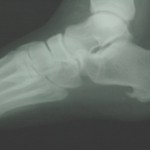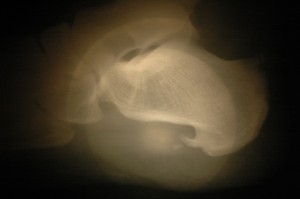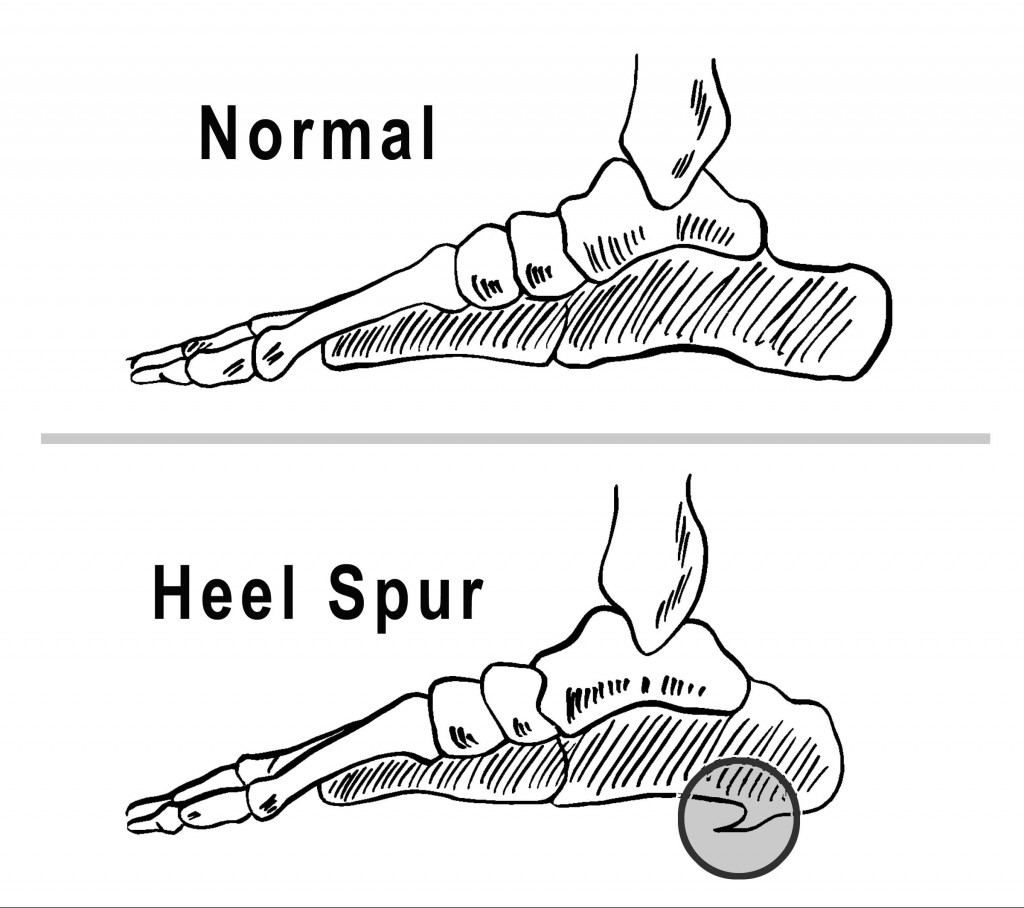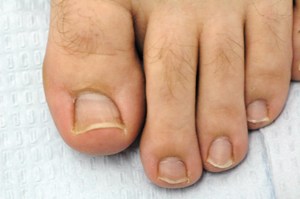Heel Spurs
Testimonials
REVIEWS OF DR. SCHULER
|
Morton’s Toe,
When you walk do you experience a painful sensation in the back part of your foot? If so, you may be suffering from heel spurs, which are abnormal bony growths in your feet. Although your heel bone has skin and fat layers that protect it from wear and tear, spurs form when there is extra pressure on the foot. The connective tissue connecting the heel to the toes gets affected, and a bony growth that presses against the heel and leads to heel spur pain will appear. This condition is common in those people who make excessive use of their feet such that there is added pressure applied to the heel.
But if simply being on your feet alot is what causes heel spurs, then wouldn’t every individual who makes excessive use of their feet have problems? Why do some people develop pain while others do not? According to Panama City podiatrist, Dr. Burton Schuler, who has treated many patients with heel spur pain, heel spurs form when there is an overpronation of the foot. One common condition that causes overpronation is called “Morton’s Toe,” Long Second Toe, and Schuler believes that the likelihood of suffering from heel, foot, or leg pain is much higher if you have a Morton’s Toehttp://whyyoureallyhurt.com/mortons-toe/heel-pain/).
A Morton’s Toe is caused by hypermobility of the first metatarsal bone, causing the second toe to be longer than the first toe. The condition is named after Dr. Dudley J. Morton, who first wrote about Morton’s Toe as early as 1928, linking it to a wide range of foot problems.
The most common reasons for heel spurs and heel pain is due to excessive stress and stains applied to the heel bone and the soft tissues structures that attach to the heel bone when we walk. This abnormal stress and strain is caused by Abnormal Pronation, which is the result of having a Morton’s Toe, Long Second Toe . Our modern-day society, where many jobs demand long hours of standing on hard concrete, that are unforgiving on our feet also contributes to heel problems. Over a period of years one of the major structures attached to the heel called the plantar fascia (this is the large rubber band structures that hold up your arch, and that goes from the heel to the ball of the foot) pulls away from the calcaneus (heel bone) and causes microscopic bleeding to occur. This bleeding can lead to ne4FB5UKWKUPXAw bone formation at the heel which eventfully leads to the formation of a bone spur. “Heel Spur Syndrome” is pain of the heel when the plantar fascia is just pulling abnormally at the heel without a spur being formed
While available medical information suggests numerous ways to treat heel spur pain, including surgery, exercise/ stretching, ice, pain creams, pain killers, special shoes and rest , Schuler maintains that simplest and most effective treatment is his toe pad, placed under the foot beneath the first metatarsal bone.
4FB5UKWKUPXAv
|

Bookmark & Share

| Heel pain is one of the most common complaints that podiatrists hear about from their patients. Most heel pain is caused by plantar fasciitis; the plantar fascia is a very thick band of tissue that has a rubber-band like structure spanning the length of the foot. When it becomes irritated or inflamed, it can result in severe pain. (On x-rays, heel spurs are seen in people with and without plantar fasciitis.)
Plantar fasciitis is most common in the following: people who are between the ages of 40 and 60; women; people who conduct strenuous exercise; obese people; people who work on their feet; and people who wear improper shoeshttp://www.mayoclinic.com/health/plantar-fasciitis/DS00508/DSECTION=risk-factors). It is also common in people who have a short first toe bone (also known as Morton’s Toe), according to Dr. Burton Schuler, a Panama City, Fl podiatrist and author of Why You Really Hurt: It All Starts in the Foot http://www.whyyoureallyhurt.com).
Morton’s Toe has a great impact on the foot’s pronation. The website explains: “Pronation allows the shock of our body weight to be absorbed when the foot meets the ground. Pronation also makes it possible for the foot to adapt to all of the different surfaces we walk on. This adaption (pronation) is only supposed take a moment so the foot can slow down in order to adjust to its new walking surface”
There are new treatments for plantar fasciitis such as Radial Shock Wave Therapy (RSWT). RSWT is an FDA approved non-surgical method for reducing foot pain and getting you back on your feet. It sends shockwaves, also known as pressure or sound waves, through the skin and on to the targeted tissue. When shockwaves make contact with the inflamed tissue they stimulate your body’s natural self-healing process http://free-news-release.com/Plantar-Fasciitis–When-Your-Heel-Bone-Becomes-Your-Hell-Bone-Detail_86246.html). Clearly, if you have heel pain and do not have Morton’s Toe, then any number of treatments–such as RSWT– may be tried. Dr. Schuler prescribes to those with Morton’s Toe and plantar fasciitis a simple toe pad placed under the first toe of each foot; a much simpler and reportedly highly effective treatment.
About the Author: Dr. Burton S. Schuler foot doctor, foot specialist, podiatrist of Panama City, Fl and the director of the Ambulatory Foot Clinics Podiatric Pain Management Center and is a leading authority on the Morton’s Toe, Long Second Toe and it associated problems. He is the author of the newly published book about The Morton’s Toe, Why You Really Hurt: It All Starts In the Foot. The book is published by the La Luz Press, Inc and is disturbed national by the Cardinal Publishing Group. Why You Really Hurt: It All Starts In The Foot, is the story of how one bone in your foot could be the real reason for pains thru out your whole body. It is important because it offer the public new information about why millions of people suffer everyday with aches and pains, and offers new hope to get rid of problems they believed they would have to live with forever. It literally can be the “medical missing link”
Dr. Schuler, graduated from the N. Y. College of Podiatric Medicine in 1975 at the age of twenty-four, and has been in private practice ever since. In 1982, he published his first book, The Agony of De-Feet: A Podiatrist Guide to Foot Care. During his thirty-five year professional career, he has written for Collier’s Encyclopedia and various podiatric journals and publications. He has been interviewed by The New York Times, First in Women, and other publications. Dr. Schuler has appeared on hundreds of radio and television programs both here and aboard. He is a Diplomate of the American Academy of Pain Management, and the National Board of Podiatric Examiners. Dr. Schuler is certified as a wound specialist from the American Board of Wound Management. His professional and civic accomplishments have earned his inclusion in the 1999-2002 Who’s Who in America (Marquis).
|

A Large Heel Spur
Many readers have probably heard of heel spurs, but they are not exactly sure what one is. The foot’s largest bone is the heel bone, and therefore it absorbs the most shock and pressure. The plantar fascia is a band of fibrous tissue on the bottom of the foot, running the entire expanse of the foot. A heel spur is an abnormal growth on the heel bone; when the plantar fascia pulls away from the heel, calcium deposits form, causing heel spurs. This can be an extremely painful condition, impairing your ability to walk properly (https://heelthatpain.com/heel-spur/treatment/).
In order to avoid a heel spur, one needs to avoid having the plantar fascia pull away from the heel. The blog “Healthy Happy Heels” is correct in stating that “…the stretching of the plantar fascia is usually the result of over-pronation…” (http://healthyhappyheels.blogspot.com/2010/12/what-is-heel-spur.html). But then we must ask, what causes over-pronation?
Dr. Dudley J. Morton, one of the leading researchers on feet in the twentieth century, warned about how a longer second toe (“Morton’s Toe”) can cause over-pronation of the foot. His predecessor, Panama City, Florida podiatrist Dr. Burton S. Schuler, explains: “If you have a Morton’s Toe the front part of the foot is unstable when it needs to be stable. Because of this, the foot will be forced to pronate. A pronating foot places abnormal stress on many areas of the foot, including the plantar fascia and the heel bone. It is this abnormal stress that is the start of all the heel problems noted above.
If a longer second toe is causing your painful heel problems, do not despair. The toe-pad that Schuler prescribes for Morton’s Toe (placed under the first toe of an over-pronating foot) can help heal those painful heels—as it already has in many cases.
About the Author: Dr. Burton S. Schuler foot doctor, foot specialist, podiatrist of Panama City, Fl and the director of the Ambulatory Foot Clinics Podiatric Pain Management Center and is a leading authority on the Morton’s Toe, Long Second Toe and it associated problems. He is the author of the newly published book about The Morton’s Toe, Why You Really Hurt: It All Starts In the Foot. The book is published by the La Luz Press, Inc and is disturbed national by the Cardinal Publishing Group. Why You Really Hurt: It All Starts In The Foot, is the story of how one bone in your foot could be the real reason for pains thru out your whole body. It is important because it offer the public new information about why millions of people suffer everyday with aches and pains, and offers new hope to get rid of problems they believed they would have to live with forever. It literally can be the “medical missing link”
Dr. Schuler, graduated from the N. Y. College of Podiatric Medicine in 1975 at the age of twenty-four, and has been in private practice ever since. In 1982, he published his first book, The Agony of De-Feet: A Podiatrist Guide to Foot Care. During his thirty-five year professional career, he has written for Collier’s Encyclopedia and various podiatric journals and publications. He has been interviewed by The New York Times, First in Women, and other publications. Dr. Schuler has appeared on hundreds of radio and television programs both here and aboard. He is a Diplomate of the American Academy of Pain Management, and the National Board of Podiatric Examiners. Dr. Schuler is certified as a wound specialist from the American Academy of Wound Management. His professional and civic accomplishments have earned his inclusion in the 1999-2002 Who’s Who in America (Marquis).
A Large Heel Spur

The Mayo Clinic website defines bone spurs as bony projections that develop along the edges of bones, rubbing against nearby nerves and bones, causing pain. They usually form where bones meet each other — in your joints. But, they can also be found where ligaments and tendons connect with bone. Most bone spurs cause no symptoms and may go undetected for years. What treatment, if any, that you receive for your bone spurs depends on where they’re located and how they affect your health http://www.mayoclinic.com/health/bone-spurs/DS00627also).
Many readers have probably heard of heel spurs, but they are not exactly sure what one is. The foot’s largest bone is the heel bone, and therefore it absorbs the most shock and pressure. The plantar fascia is a band of fibrous tissue on the bottom of the foot, running the entire expanse of the foot. A heel spur is an abnormal growth on the heel bone; when the plantar fascia pulls away from the heel, calcium deposits form, causing heel spurs. This can be an extremely painful condition, impairing your ability to walk In order to avoid a heel spur, one need to avoid having the plantar fascia pull away from the heel. Dr. Burton S. Schuler, podiatrist of Panama City Fl” is correct in stating that “…the stretching of the plantar fascia is usually the result of over-pronation. ww w. Footcare4u.com But then we must ask, what causes over-pronation?
Dr. Dudley J. Morton, one of the leading researchers on feet in the twentieth century, warned about how a short first metatarsal bone (“Morton’s Toe”) (Long Second Toe) can cause over-pronation of the foot. Dr Schuler, explains: “If you have a Morton’s Toe the front part of the foot is unstable when it needs to be stable. Because of this, the foot will be forced to pronate. A pronating foot places abnormal stress on many areas of the foot, including the plantar fascia and the heel bone. It is this abnormal stress that is the start of all the heel problems noted above” (http: www.whyyouhurt.com).
If a longer second toe is causing your painful heel problems, do not despair. The toe-pad that Schuler prescribes for Morton’s Toe (placed under the first toe of an over-pronating foot) can help heal those painful heels—as it already has in many cases.
Dr. Burton S. Schuler is a foot doctor, foot specialist (Podiatrist), of Panama City, Fl and the director of the Ambulatory Foot Clinics Podiatric Pain Management Center. He is also the author of the new book Why You Really Hurt: It All Starts In The Foot

Heel Spur
The Mayo Clinic website defines bone spurs as bony projections that develop along the edges of bones, rubbing against nearby nerves and bones, causing pain. They usually form where bones meet each other — in your joints. But, they can also be found where ligaments and tendons connect with bone. Most bone spurs cause no symptoms and may go undetected for years. What treatment, if any, that you receive for your bone spurs depends on where they’re located and how they affect your health http://www.mayoclinic.com/health/bone-spurs/DS00627also).
Many readers have probably heard of heel spurs, but they are not exactly sure what one is. The foot’s largest bone is the heel bone, and therefore it absorbs the most shock and pressure. The plantar fascia is a band of fibrous tissue on the bottom of the foot, running the entire expanse of the foot. A heel spur is an abnormal growth on the heel bone; when the plantar fascia pulls away from the heel, calcium deposits form, causing heel spurs. This can be an extremely painful condition, impairing your ability to walk In order to avoid a heel spur, one need to avoid having the plantar fascia pull away from the heel. Dr. Burton S. Schuler, podiatrist of Panama City Fl” is correct in stating that “…the stretching of the plantar fascia is usually the result of over-pronation. ww w. Footcare4u.com But then we must ask, what causes over-pronation?
Dr. Dudley J. Morton, one of the leading researchers on feet in the twentieth century, warned about how a short first metatarsal bone (“Morton’s Toe”) (Long Second Toe) can cause over-pronation of the foot. Dr. Schuler, explains: “If you have a Morton’s Toe the front part of the foot is unstable when it needs to be stable. Because of this, the foot will be forced to pronate. A pronating foot places abnormal stress on many areas of the foot, including the plantar fascia and the heel bone. It is this abnormal stress that is the start of all the heel problems noted above” (http: www.whyyouhurt.com).
If a longer second toe is causing your painful heel problems, do not despair. The toe-pad that Schuler prescribes for Morton’s Toe (placed under the first toe of an over-pronating foot) can help heal those painful heels—as it already has in many cases.
Dr. Burton S. Schuler is a foot doctor, foot specialist (Podiatrist), of Panama City, Fl and the director of the Ambulatory Foot Clinics Podiatric Pain Management Center. He is also the author of the new book Why You Really Hurt: It All Starts In The Foot

Bookmark & Share
WHAT IS A HEEL SPUR? The heel bone is the largest bone in the foot and absorbs the most stress. A heel spur is an abnormal growth of bone either at the back of the heel, or most commonly on the bottom of the heel. The most common symptom of a heel spur is to have pain when first getting out of bed in the morning, or after resting for 20 minutes then getting up.
 WHY DO WE GET HEEL SPURS OR HEEL SPUR SYNDROME? The most common reasons for heel spurs and heel pain is due to excessive stress and stains applied to the heel bone and the soft tissues structures that attach to the heel bone when we walk. This abnormal stress and strain is caused by Abnormal Pronation, which is the result of having a Morton’s Toe Our modern-day society, where many jobs demand long hours of standing on hard concrete, that are unforgiving on our feet also contributes to heel problems. Over a period of years one of the major structures attached to the heel called the plantar fascia (this is the large rubber band structures that hold up your arch, and that goes from the heel to the ball of the foot) pulls away from the calcaneus (heel bone) and causes microscopic bleeding to occur. This bleeding can lead to new bone formation at the heel which eventfully leads to the formation of a bone spur. “Heel Spur Syndrome” is pain of the heel when the plantar fascia is just pulling abnormally at the heel without a spur being formed.
WHY DO WE GET HEEL SPURS OR HEEL SPUR SYNDROME? The most common reasons for heel spurs and heel pain is due to excessive stress and stains applied to the heel bone and the soft tissues structures that attach to the heel bone when we walk. This abnormal stress and strain is caused by Abnormal Pronation, which is the result of having a Morton’s Toe Our modern-day society, where many jobs demand long hours of standing on hard concrete, that are unforgiving on our feet also contributes to heel problems. Over a period of years one of the major structures attached to the heel called the plantar fascia (this is the large rubber band structures that hold up your arch, and that goes from the heel to the ball of the foot) pulls away from the calcaneus (heel bone) and causes microscopic bleeding to occur. This bleeding can lead to new bone formation at the heel which eventfully leads to the formation of a bone spur. “Heel Spur Syndrome” is pain of the heel when the plantar fascia is just pulling abnormally at the heel without a spur being formed.
Heel Bursitis, Besides the heel itself being affected, there is a fluid containing sac covering the heel called a bursa. The bursa acts as a shock absorber for the tremendous forces that goes through the heel. This bursa will get abnormally swollen and inflamed when the heel is injured as noted above, resulting in a Bursitis. The medical term for this is a Calcaneal Bursitis and is the cause of the pain upon getting out of bed in the morning or pain upon raising after resting, either at the heel spur on the bottom and or back of the heel bone.
Plantar Fasciitis is a condition where the plantar fascia gets swollen and inflamed, again due to abnormal pronation. Normally it hurts upon standing but normally goes away walking awhile. Surgery is very rare, and conservative treatment is the same as heel spur (see below)
Other causes of heel pain include: physical injury, obesity, poor shoes, muscle inflammation, gout, nerve problem (Tarsal Tunnel Syndrome,) strain of the plantar arch,arthritis or simply excessive walking or standing.
I am of the firm belief that heel spurs lay dormant for years like volcanos. One of the most amazing thing about heel spurs is that at this very moment there are millions of people walking around the world who have massive heel spurs who are not having one drop of pain, and have no idea in the world that they have heel spurs. Many people go thru their entire life with heel spurs who don’t have any heel pain. It is not unusual for me to see a patient who complains of heel pain of about 2-3 months, to have a spur on x-ray that from its size, had to have been there for 20 years. Again I believe something will trigger the heel pain out of the blue when a large spur has been there for many years.
Self-treatment in the early stages of heel pain may include stretching exercises, elevation of the heel, using over the counter anti-inflammatory medications, ice or heat (I prefer heat), losing weight, padding the heel with a soft foam rubber material, or wearing shoes with a thick rubber heel which act as a shock absorber.
If the condition does not respond to such treatment, it is time to consult a podiatrist who will compile a careful medical history and perform a detailed examination of the foot. X-rays are normally needed to assist in determining the nature of the problem. At the Ambulatory Foot Clinic we also employ Thermography in all of our exams for heel pain This allows us to see inside your foot and see your pain. There are only a handful of foot specialist in the Southeast who have this state of the art ability in their offices.
Children can also have severe heel problems. Between the ages of 9 and 13 they can experience pain on the side of the heel caused by an irritation to the growth plate, and is called Calcaneal Apophysitis, or Sever’s Disease. This condition can become serious and should be immediately evaluated by a podiatrist.
Heel spurs and heel pain is the most common problems seen at the Ambulatory Foot Clinic-Podiatric Pain Management Center. Our treatments for these complex problems are not to give painful injections or perform surgeries immediately, but instead use the time proven, highly successful, relatively pain free treatments such as stress free Physical Therapy, medications and removal of the abnormal stress and strain on the heel (which were and are the real cause of the problem) with padding and strapping and then Orthotics to control the underlying Abnormal Pronation which many times is due to Morton’s Toe. There are many highly successful non-surgical treatments for heel spurs and related conditions that give long term relief by treating the abnormal bone pressure. Foot surgery for heel pain is rare and should always be a last resort, but if needed, it is done using minimal incision techniques, in the comfort and privacy of our Clinic.







 WHY DO WE GET HEEL SPURS OR HEEL SPUR SYNDROME? The most common reasons for heel spurs and heel pain is due to excessive stress and stains applied to the heel bone and the soft tissues structures that attach to the heel bone when we walk. This abnormal stress and strain is caused by
WHY DO WE GET HEEL SPURS OR HEEL SPUR SYNDROME? The most common reasons for heel spurs and heel pain is due to excessive stress and stains applied to the heel bone and the soft tissues structures that attach to the heel bone when we walk. This abnormal stress and strain is caused by